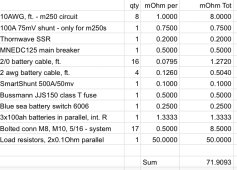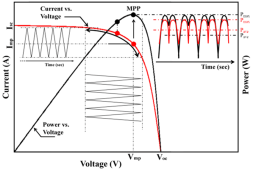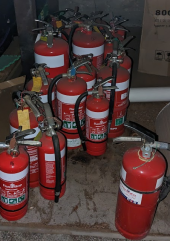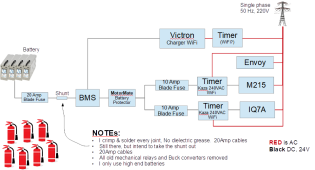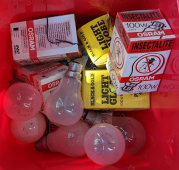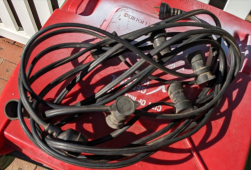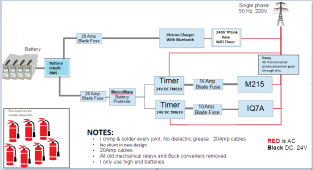Thought I'd put together a summary regarding working/not-working setups since I'm catching up on the 14 pages, mostly it seems centered around what
@agt reported:
Solid Red: For all M250 models and for M215-60-2LL-S22-IG, this indicates a “DCResistance Low – Power Off” fault....
An insulation resistance (IR) sensor in the microinverter measures the resistance between the positive and negative PV inputs to ground. If either resistance drops below a threshold, the microinverter stops power production
It was speculated that the resistance check may not be from
+ to -, but rather
+ to ⏚ and
- to ⏚.
In general,
@kundip and others seem methodical and practical, so I imagine they're following generally good practices regarding crimps, tightening, and dielectric grease. Note this recap doesn't include some fascinating findings (e.g.,
@jimbob232's
discovery about inductors for PWM). Despite that, it's not really clear what components are in the DC path for working versus non-working setups, or what their electrical impacts might be.
As the thread ages things change, so please don't freak out. Also paraphrased a lot of it to be concise, please correct anything I got wrong and apologies in advance:
In
post #26 @newbostonconst says it works for him, he has a Victron Shunt. It's not his first rodeo, so the stuff between is probably: breakers, shunt, battery protector, BMS, relay, wire, and a bunch of crimps. Hopefully, they can confirm/deny.
In
#46 @newbostonconst reports getting the DC Resistance light after reconfiguring his pack from 55 Ah to 550ah pack 20 cells 66 volts. No information on grounding.
In post
#27 @kundip mentions he has a shunt. He also mentions that he has both IQ7s
and M215s, which could have different detection ranges (not to mention he's at 50 Hz which was later
pointed out isn't mentioned as having DC resistance checks)
In
#49 @agt posted a video suggesting battery voltage over Vmpp inhibits V/A-seeking on M190s. But in post
#109 @kundip shares his experience if you go over the voltage the micro shuts down.
In
#52 @ericgrand reports no problems with M215 microinverters & 6 Valence U27-12XP batteries (2S-3P)
In post
#59 @AntronX reports it working with a Power Supply from 14.1V to 47.8V DC input (>22V to startup) and maxes out at 10A below 25.5V.
In post
#60 @markdyer reports success with m230 micros & 36v esccoter batteries
In post
#64 @kundip posts photos of his system with buck converter (which he no longer recommends). Don't see thick cables from the BMS to the battery, so output power probably doesn't go through the BMS (post
#136 seems to indicate it does)? In
#66 he says he has 15 amp fuses, not breakers. In
#68 he says he few interesting things:
- a 24v 30amp relay (looks like an automotive mechanical rather than SSR).
- I don't run ...current through the Victron Battery Saver ...It kept on complaining about "inrush current"
- use the Victron to turn on and control the relay. The Victron cuts off the battery @ 24v. ???
Post
#76 is from a few weeks ago and
@kundip's latest design. Looks like there's no shunt, no battery protector, no breakers - just the battery and a "kaza" timer (looks a bit like a high-amp AC pool-pump mechanical timer). This is probably just an image of the AC side?? (confirmed later it is DC).
In post
#80 @kundip says he is using the Power Mate battery protector, possible behind the board in #76? He also says he used high-end batteries: Amptrons or EVPower Batteries. Also has two 5 KG dry powder fire extinguishers, big thumbs up! Wonder if those are automatic or manual...not in the photos.
In post
#82 there's an image of the
current setup showing the AC side and partially the DC sides? A 20 amp fuse and a battery protector are marked, but can't tell if a shunt is in there or if he's still using a relay (with the AC output setup a relay on the DC side shouldn't be needed).
In addition to the 20 amp fuse on the motormate, each micro has a 10 amp fuse.
In post
#136 @kundip says the timers are on the
DC side, there's an image in
#139 that seems to agree... but that image also has a relay before the timer? He also says the BMS can cut the battery off, so it must also be between the battery and micros on the DC side, but it's not shown in #139. His desire to be neat and tidy makes it impossible to track the wiring.
In post
#154 @jimbob232 reports using PWM to throttle output was successful (I was thinking along the same lines before I decided microinverter outputs were granular enough
a relay bank simplified the complexity).
In post
#230 @fafrd has some experimental data with resistors, but it didn't make sense to me. In
#248 he reiterates. His resistance is
+ to - and seems centered around stabilizing the MPPT tracking, rather than eliminating the DCResistance Low faults.
In Post
#229 @agt says he was able to bypass the DC resistance check at 2.5W loss.
Profiles?
Enphase's micros are controlled by their profiles, so possibly it's the profile causing the different behaviors. Although,
@newbostonconst 's experience with just switching the batteries causing failures does point more towards internal resistance.
It would be interesting if those with Envoy's could tell us what profiles work for them.
@jimbob232 reports the UK profile, but if it's like here there's probably a dozen of them.
Summary of the Summary
There's no clear diagram of a working sytem end to end. It's not always clear if the problem is the DCResistance Low or if it's a failure of MPPT tracking to lock on.



